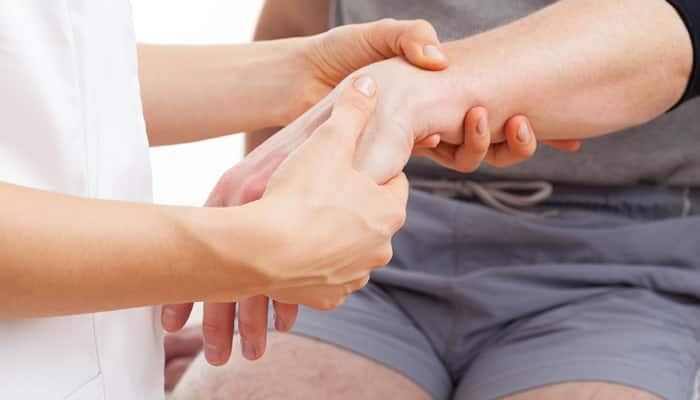Zee Media Bureau
New Delhi: Wrist tendonitis, also called tenosynovitis, is a common condition characterized by irritation and inflammation of the tendons around the wrist joint. Tendonitis occurs at points where the tendons of the wrist cross each other or pass over a bony prominence.
Tendons are tough, flexible, fibrous bands of tissue that connect muscles to bones. They can be small, like the delicate, tiny bands in the hands, or large, like the heavy, rope-like cords that anchor the calf or thigh muscles. When tendons become inflamed, irritated or suffer microscopic tears, the condition is called Tendonitis.
The tendon sheaths have a fluid within the sheath called synovial fluid, and when this becomes inflamed, the condition is called tenosynovitis.
In most cases, the cause of tendonitis is unknown; when a cause can be identified, the condition usually happens for one of two reasons: Overuse of a particular body motion or overdoing of a certain activity, such as weightlifting etc. Dr Swapnil Zambre, Orthopaedic, Fortis Hospital Kalyan, talked about the signs and symptoms of wrist tendonitis, including treatment and prevention.
Signs of wrist tendonitis
The most common and consistent complaint of patients diagnosed with Wrist Tendonitis is a pain in the wrist. Other include swelling around the wrist, warmth and redness of the tendons, grinding sensations (crepitus) with movement of the tendons.
The diagnosis of Wrist Tendonitis is made by looking for the characteristic signs of this condition. In addition, depending on the tendon that is inflamed, the physician may perform tests that stretch the specific tendons of concern to locate the precise source of inflammation.
Treatment of wrist tendonitis
Typically, such conditions are treated with medications, physical therapy, or even surgeries. For some cases of non-infectious tendonitis, the Orthopaedic surgeon may consider injecting a steroid drug into the affected tendon.
Immobilization: Placing the wrist in a splint or a cast is usually the first treatment step. Wrist tendonitis is due to recurrent irritation of the tendon and its sheath. By resting the tendon, the inflammation should decrease.
Icing the injury: Applying an ice pack intermittently to the area of inflammation may also be beneficial. It helps cool inflammation and stimulates blood flow to the area of tendonitis.
Anti-inflammatory medications: Non-steroidal anti-inflammatory medications help control symptoms of pain, but more importantly, they help treat Wrist Tendonitis to decrease inflammation and swelling of the soft tissues. These treatment medications will decrease the inflammatory response, which is the cause of the pain.
Cortisone injection: Cortisone is a more powerful anti-inflammatory treatment option that is given by injection directly to the site of inflammation. Cortisone injections are safe, but can weaken tendons over time if too many injections are given.
Surgery: Surgery is recommended only when the above-mentioned other treatment methods fail to fix the problem. If that is the case, the area of tight tendon sheath that causes the painful and difficult tendon movements can be released. The inflammatory tissue can also be removed in an effort to create more space for the tendon to move freely.
In rare occasions, the doctors may opt for a preparation known as platelet-rich plasma (PRP), which has potential to avoid or delay surgery if used for right indication. PRP is blood plasma that has been enriched with platelets – more than what is typically found in blood. The concentration of platelets — and, thereby, the concentration of growth factors — can be 5 to 10 times greater (or richer) than usual. As a concentrated source of autologous platelets, PRP contains several different growth factors and other cytokines that stimulate healing of bone and soft tissue. Athletes around the world including Tiger Woods and Rafael Nadal have received PRP for various problems, such as sprained knees and chronic tendon injuries. Some athletes have credited PRP for their quick return to competition.
Prevention
There are a number of preventive measures to avoid flare-ups of wrist tendonitis. The most important step is to modify any specific activity that seems to aggravate the condition. Changing the position of hands when performing activities can ensure no single tendon takes too much of the load. Wearing a splint during activities that irritate your tendonitis can be helpful, but this may also be cumbersome. Certainly a simple support wrap or brace can be an easy way to avoid symptoms.
Patients are advised to observe caution while taking medications before activities, as sometimes this can simply cover up symptoms, when it may be better for the patient to be able to assess when he/she is overdoing an activity. Gentle stretching and heat before an activity can ensure the tendons are ready, and an ice pack afterwards can quiet any inflammation. If the patient is unable to keep control of the symptoms, it is advisable to see an Orthopaedic doctor.
















